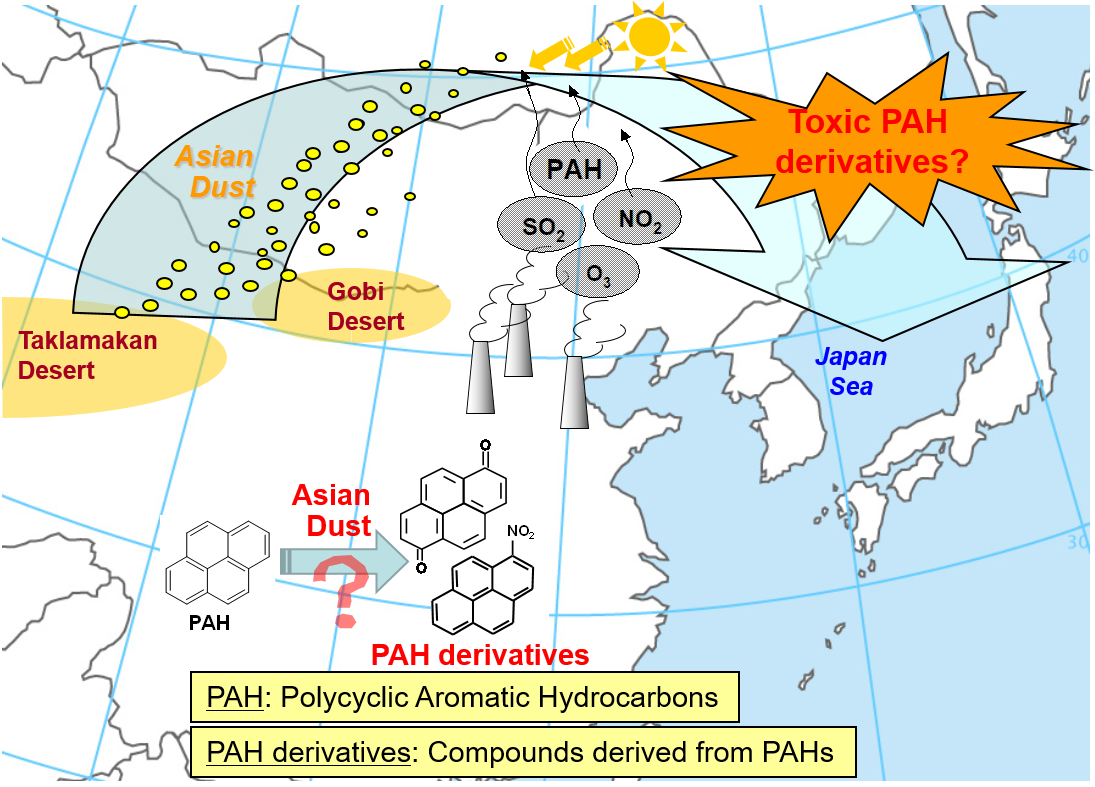RESEARCH
Air pollution due to toxic chemicals formed on mineral dust aerosols
It is known that Asian Dust, which occurs on the Chinese continent and reaches Japan, has an aggravating effect on allergic symptoms such as asthma, but the mechanism is not well understood. We have hypothesized that "Air pollutants attached to Asian Dust are one of the factors causing such health damage" and are working to verify this hypothesis.
Secondary formation of carcinogenic nitrated PAHs on mineral dust aerosols
PAH (Polycyclic Aromatic Hydrocarbons) is an air pollutant generated when fossil fuels are burned. It occurs in large quantities on the Chinese continent, and it has been pointed out that some of it may be transported with the Asian Dust, a kind of mineral dust aerosol. We found that PAHs attached to Asian Dust particles react with NOx (nitrogen oxide) and are easily converted to nitrated PAHs, which are carcinogens (Kameda et al., Sci. Rep. 6, 24427, 2016). It is possible that mineral dust aerosols act as a catalyst to promote chemical reactions that occur in the atmosphere, thus producing these toxic chemicals.
Secondary formation of quinoid PAHs on mineral dust aerosols
Quinoid PAH, an oxidized form of PAH, is known to have an aggravating effect
on allergic symptoms as is the case with the Asian Dust. If, like nitrated
PAHs, quinoid PAH is readily produced on Asian Dust particles, it may be
closely related to the aggravating effects of Asian Dust on allergic symptoms.
We are currently working on observations and laboratory experiments to
verify this.
 Image of the toxic PAH derivatives formed on the surface of Asian Dust
particles
Image of the toxic PAH derivatives formed on the surface of Asian Dust
particles
Development of analytical methods for toxic chemicals in the air

Many of the harmful chemical substances contained in atmospheric particles have extremely low concentrations, and in order to clarify their abundance and behavior in the environment, it is important to establish methods to measure them with high sensitivity and precision. Therefore, we are working on the development of new methods for measuring hazardous chemical substances in atmospheric particles using high-performance liquid chromatography (HPLC) and gas chromatography-mass spectrometry (GC-MS) (e.g., Kameda et al., J. Chromatogr. A, 1216, 6758, 2009; Kameda et al., Bunseki Kagaku, 62, 979, 2013; Kamiya et al., Polycyclic Aromat. Compd., 37, 128, 2017).
Hazard assessment of particulates based on their oxidizing ability
As mentioned above, quioid PAHs show the aggravating effect on allergic symptoms as is the case with the Asian Dust. One of the factors is considered to be Reactive Oxygen Species (ROS) generated by quinoid PAHs taken into the body. Excessive generation of ROS in vivo is thought to cause oxidation and damage of proteins and DNA, resulting in various diseases. Atmospheric particles contain many chemical substances that cause excessive generation of ROS. Therefore, we are trying to clarify the ROS generation ability of atmospheric particles and chemicals contained in atmospheric particles by using a method called the dithiothreitol (DTT) assay, which evaluates the ROS generation ability based on the reaction rate with DTT (Okubo et al., Polycyclic Aromat. Compd., 42, 5152, 2022.).
